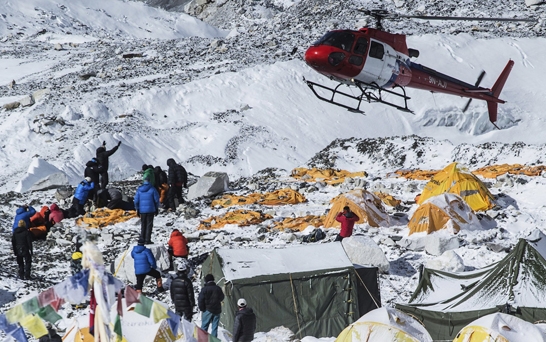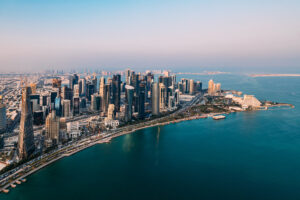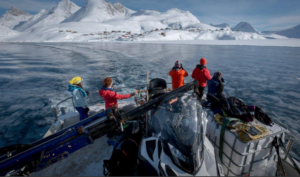Climbers call off Everest expeditions after earthquake

TBN —
Kathmandu : Mountaineering teams have called off Everest expeditions for second year after destruction of routes on the world’s highest peak following avalanche and devastating earthquake of April 25, 2015.
The 7.8-magnitude earthquake destroyed 2,99000 private houses and 10,382 government buildings in 14 earthquake hit districts of the country.
More than 8,029 people have died and 17,784 injured in the devastating earthquake. At least 19 climbers and support guides lost their lives in avalanche in the Everest Base Camp.
Climbing companies said they had cancelled their expeditions due to fear of aftershocks and destruction of the route to the summit.
Some 800 climbers were on everest region when the avalanche roared through base camp sparked by a massive earthquake .
The disaster was the worst to hit Everest , one year after another avalanche killed 16 Nepalese guides on April 18 ,2014 , sparking an unprecedented shutdown of the 8,848-metre (29,029-foot) high mountain.
Department of Tourism , MoCTCA Nepal had issued permits for 340 foreigners and 18 Nepalis this year, including 118 permits to those who abandoned expeditions last year.
BBC writes –
Climbing Mount Everest this season is “almost impossible” because the routes have been damaged by avalanches triggered by last month’s earthquake, officials in Nepal say.They warn that it will take time for the routes to be remade. The government has not announced an official decision.
At least 19 people were killed in the avalanches.The 7.8-magnitude earthquake is now known to have killed more than 7,000 people and injured more than 10,000.
Most climbers have now left the Base Camp and abandoned their expeditions, Sherpa porters based there have told the BBC.
Officials of the Sagarmatha Pollution Control Committee (SPCC) told the BBC that “icefall doctors” – who are expert rope and ladder-fixing Sherpas – decided that further climbs were impossible this spring after inspecting avalanche-hit areas of the mountain.
The Sherpas say that climbing routes have been badly damaged and in places blocked by huge chunks of ice that were shifted by the quake.
Mountaineering firms – many of whose climbers were killed by the avalanches – have now decided to abandon ascent plans after losing a huge amount of equipment, including scores of climbing ladders, in the snow.
Almost a year ago another avalanche at the world’s highest peak claimed the lives of 16 Sherpa guides.
At the moment the Nepalese government is refusing to officially announce that there will be no more climbing on Everest this year.
It knows it would be an unprecedented move because it would be the second year in a row.
And that could have implications for the country’s vital tourism industry of which mountaineering and trekking are major parts.
Those climbers who had wanted to continue their Everest expeditions will be frustrated, while many of the teams will want their permits carried over to next year, which will mean a loss of revenue for the government.
A senior official had also told the BBC earlier that they wanted to normalise the situation in the country as quickly as possible after the earthquake to minimise the damage to the tourism industry.
The government appears to be leaving the decision about scaling Everest to individual climbers – 357 were registered for this climbing season.
Similarly , Ryan Grenoble writes in ‘ The Huffington Post ” –
In addition to taking a devastating humanitarian toll, the 7.8-magnitude earthquake that hit central Nepal on April 25 also shrank Mount Everest.
The world’s tallest mountain shrank by about one inch in the quake, according to information provided by UNAVCO, a nonprofit geoscience research consortium, to the site LiveScience. The analysis is based on data from the European Space Agency Sentinel-1A satellite, which passed over the affected area for the first time on April 29.
When the fault between the India and Eurasia tectonic plates slipped, causing the earthquake, strain was released that allowed the Earth’s crust to relax. That relaxation led to a slight reduction of the height of Everest.
In an email to The Huffington Post, Roger Bilham, a fellow at the Cooperative Institute for Research In Environmental Sciences and a professor in geological sciences at the University of Colorado Boulder, estimates that Everest shrank by one or two millimeters, while the Annapurna Range, a mountain range located in central Nepal closer to the earthquake, actually grew by 20 centimeters, or roughly 8 inches.
Similarly to the Annapurna Range, an area around Nepal’s capital city of Kathmandu was actually lifted up vertically by around 3 feet, according to an analysis by the German Aerospace Center. The area is estimated to be more than 55 miles long and 18 miles wide.
May 6, 2015














